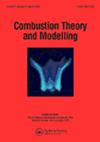基于熵产分析的燃料自燃层流燃烧机理还原方法
IF 1.6
4区 工程技术
Q4 ENERGY & FUELS
引用次数: 0
摘要
摘要本文提出了一种基于熵产分析的自燃和层流火焰化学机理还原策略,提高了层流燃烧速度的预测精度。除化学反应外,改进的方法还考虑了其他引起熵产生的不可逆源,如质量扩散和热传导。具体来说,最初的骨架机制首先是基于在自燃过程中产生熵的重要反应产生的。然后构建机制补丁,包括重要的物质和反应,这些物质和反应分别有助于层流预混火焰的质量扩散和热传导产生超过预定义阈值的熵。最后,将初始骨架机制和机构补丁相结合,建立最终骨架机制。通过这种方法,从详细的POLIMI机制(451种,17848个反应)发展出了两个最终的骨架机制,分别包含162种,2276个反应和160种,1916个反应。两种最终骨架机制被证明可以准确地预测正十二烷火焰的层流燃烧速度和熵产生,与详细机制相比,模拟结果变化不大,而它们预测点火延迟时间的准确性依赖于初始骨架机制。具体而言,160种和1916种反应的简化机制在预测点火延迟方面的表现不如162种和2276种反应的简化机制令人满意,这表明通过均匀自燃过程的熵产分析生成初始骨架机制所需的阈值较低。此外,与其他机构缩减策略获得的相似尺寸的缩减机构相比,两种最终骨架机构准确地捕获了层流燃烧速度和点火延迟时间的特征,所需的计算时间相似。关键词:机制约简熵产分析均匀自燃层流火焰十二烷披露声明作者未报告潜在的利益冲突。基金资助:国家自然科学基金项目[批准号:520106261和52022058];中国博士后科研基金项目[批准号:2022M712042和2022T150403]。本文章由计算机程序翻译,如有差异,请以英文原文为准。
A combustion mechanism reduction method based on entropy production analysis in fuel auto-ignition and laminar flames
AbstractThis study provides a chemical mechanism reduction strategy based on entropy production analyses in both auto-ignition and laminar flames, which enhances the predictive accuracy for laminar burning velocities. In addition to chemical reactions, other irreversible sources causing entropy generation, such as mass diffusion and heat conduction, are considered in the modified approach. Specifically, initial skeletal mechanisms are first generated based on important reactions that contribute to entropy production in auto-ignition processes. Mechanism patches are then constructed to include important species and reactions, which contribute to entropy production from mass diffusion and heat conduction in laminar premixed flames beyond the pre-defined thresholds, respectively. Finally, the initial skeletal mechanisms and mechanism patches are combined to establish the final skeletal mechanisms. In this way, two final skeletal mechanisms for n-dodecane, consisting of 162 species and 2276 reactions, and 160 species and 1916 reactions, respectively, are developed from the detailed POLIMI mechanism with 451 species and 17,848 reactions. The two final skeletal mechanisms are proven to accurately predict laminar burning velocities and entropy production in n-dodecane flames with insignificant variations in the simulation results compared to the detailed mechanism, while their accuracy in predicting ignition delay times relies on the initial skeletal mechanisms. Specifically, the reduced mechanism with 160 species and 1916 reactions exhibits less satisfactory performance in predicting ignition delay compared to that with 162 species and 2276 reactions, indicating that a lower threshold is required to generate the initial skeletal mechanism through entropy production analysis of homogeneous auto-ignition processes. Additionally, compared with the reduced mechanisms with similar sizes obtained with other mechanism reduction strategies, the two final skeletal mechanisms accurately capture the characteristics of laminar burning velocities and ignition delay times, with similar calculation time required.Keywords: mechanism reductionentropy production analysishomogeneous auto-ignitionlaminar flamen-dodecane Disclosure statementNo potential conflict of interest was reported by the author(s).Additional informationFundingThis work is supported by the National Natural Science Foundation of China [grant numbers 52106261 and 52022058], the Postdoctoral Research Foundation of China [grant numbers 2022M712042 and 2022T150403].
求助全文
通过发布文献求助,成功后即可免费获取论文全文。
去求助
来源期刊

Combustion Theory and Modelling
工程技术-工程:化工
CiteScore
3.00
自引率
7.70%
发文量
38
审稿时长
6 months
期刊介绍:
Combustion Theory and Modelling is a leading international journal devoted to the application of mathematical modelling, numerical simulation and experimental techniques to the study of combustion. Articles can cover a wide range of topics, such as: premixed laminar flames, laminar diffusion flames, turbulent combustion, fires, chemical kinetics, pollutant formation, microgravity, materials synthesis, chemical vapour deposition, catalysis, droplet and spray combustion, detonation dynamics, thermal explosions, ignition, energetic materials and propellants, burners and engine combustion. A diverse spectrum of mathematical methods may also be used, including large scale numerical simulation, hybrid computational schemes, front tracking, adaptive mesh refinement, optimized parallel computation, asymptotic methods and singular perturbation techniques, bifurcation theory, optimization methods, dynamical systems theory, cellular automata and discrete methods and probabilistic and statistical methods. Experimental studies that employ intrusive or nonintrusive diagnostics and are published in the Journal should be closely related to theoretical issues, by highlighting fundamental theoretical questions or by providing a sound basis for comparison with theory.
 求助内容:
求助内容: 应助结果提醒方式:
应助结果提醒方式:


